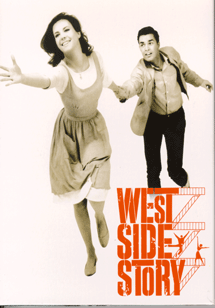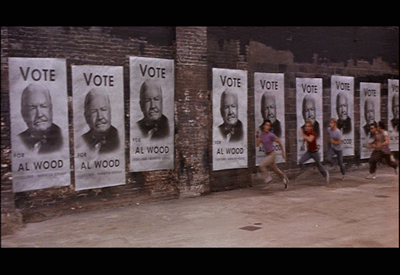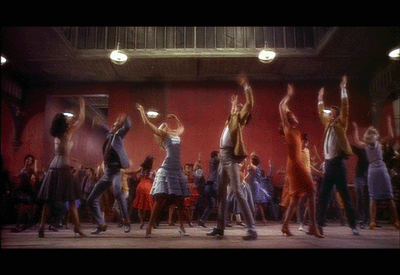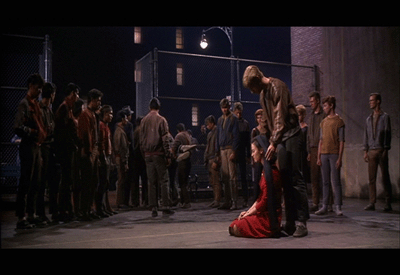
CINEMATIC ALLUSIONS TO LITERARY WORKS
WEST SIDE STORY (1961)

Using the skeleton of Shakespeare's plot, the creative team of choreographer and director Jerome Robbins, composer Leonard Bernstein, and lyricist Stephen Sondheim turned Romeo and Juliet first into an immensely successful Broadway musical and then into an Academy Award winning motion picture. Shakespeare's feuding Montagues and Capulets became rival ethnic street gangs defending their Hell's Kitchen neighborhood turf. The anger of macho teenagers boils over and explodes in the pressure-cooker of city streets and callous adults' authority. Lyrical romantic love between a Puerto Rican girl and a Polish boy can't survive in such a violent world.
The film's grim vision of the urban ghetto was part of America's fantasy of a suburban paradise. Central cities were bulldozed for "urban renewal," and the middle class fled to the new but sterile suburbs. The opening sections of West Side Story were filmed in the vibrant neighborhood that was being cleared out to make way for the monolithic marble structures of Lincoln Center.
Shakespeare depended on the energy of his language to build the exuberant and deadly beauty of his story. His acting company also used short interludes of vigorous dance, song, and choreographed sword-fighting as parts of the overall effect of Romeo and Juliet on stage. Sondheim's lyrics, Bernstein's music, and Robbins' choreography imitate the Dionysian energy that Shakespeare drew on as well.
Steven S. Urkowitz, Ph.D.
Professor, English
Theatre and Speech Program
West Side Story. Dir. Robert Wise and Jerome Robbins. Perf. Natalie Wood, Richard Beymer, Rita Moreno, and Russ Tamblyn. DVD. United Artists, Mirisch Picture Inc., in Association with Seven Arts Production Inc., 1961.
 |
The abstract civic authority represented by the political posters glued up on ghetto walls alludes to Shakespeare's Prince Escalus in Romeo and Juliet. Shakespeare's Prince feels and eloquently describes the effects of the city's violence when his own kinsmen are killed. The mayoral candidate stares blindly over the passions streaming past his image. |
The energy of popular dance opens possibilities of social delight and love. Here Jerome Robbins choreographs a high school dance that introduces Tony (Richard Beymer) and Maria (Natalie Wood), West Side Story's Romeo and Juliet. Shakespeare's equivalent is a yearly feast celebrated by the Capulets attended by all the lively people of the city. |
 |
 |
Against the context of death and vengeance, rival gang members of the Jets and Sharks jointly carry out the body of Tony (Richard Beymer). A Jet, "Baby John" (Sue Oakes), gracefully covers the former "enemy" Maria (Natalie Wood) with a mourning shawl. The police stand by. The city is being leveled around them. |
Bibliography
Biesen, Sheri Chinen. "'West Side Story', Kennedy's Camelot and Postwar to Early 1960's America." Popular Culture Review 11.1 (2000): 107-24.
Garebian, Keith. The Making of West Side Story. Toronto: ECW, 1995.
Sandoval-Sánchez, Alberto. "A Puerto Rican Reading of 'America': 'West Side Story'." Jump Cut: A Review of Contemporary Media 39 (1994): 59-66.
| Previous Movie | Return to main page | |
Copyright © The City College Library www1.ccny.cuny.edu/library |
||